Sustainability Assessment of Intensified Forestry—Forest Bioenergy versus Forest Biodiversity Targeting Forest Birds
Abstract
:1. Introduction
- Assess the forest bioenergy feedstock yields for each strategy;
- Assess forest biodiversity indicators in the form of total habitat area of forest meeting species-specific age criteria, tailored for forest bird diversity, as well as forest edge and forest interior habitat.
2. Materials and Methods
2.1. Study Area
2.2. Overview of Data and Methodology
2.2.1. Forest Bioenergy Feedstock
2.2.2. Forest Biodiversity Components—Forest Bird Habitat
3. Results
3.1. Forest Bioenergy Feedstock
3.2. Forest Older Than 70 Years
3.3. Forest Biodiversity Indicators—Forest Bird Habitat
3.4. Trade-Offs
4. Discussion
5. Conclusions
Author Contributions
Funding
Institutional Review Board Statement
Informed Consent Statement
Data Availability Statement
Conflicts of Interest
Appendix A
| (a) Branches and Tops | Dominating Tree Species | |||||||
|---|---|---|---|---|---|---|---|---|
| Pine | Spruce | Birch | Aspen | Black Alder | Grey Alder | Oak | Ash | |
| Soil type | Volume Expansion of Harvested Stem Volume (%): Branches and Tops | |||||||
| VEF1: steep, poor eroded, organic poor | 0 | 0 | 0 | 0 | 0 | 0 | 0 | 0 |
| VEF2: dry poor, moist poor, organic eroded | 2 | 3 | 2 | 2 | 2 | 2 | 3 | 3 |
| VEF3: dry with some fertility | 10 | 12 | 12 | 10 | 10 | 10 | 10 | 10 |
| VEF4: dry with high fertility | 12 | 15 | 14 | 12 | 10 | 10 | 13 | 15 |
| (b) Stumps | Dominating Tree Species | |||||||
| Pine | Spruce | Birch | Aspen | Black Alder | Grey Alder | Oak | Ash | |
| Soil type | Volume Expansion of Harvested stem Volume (%): Stumps | |||||||
| VEF1: steep, poor eroded, organic poor | 0 | 0 | 0 | 0 | 0 | 0 | 0 | 0 |
| VEF2: dry poor, moist poor, organic eroded | 4 | 4 | 3 | 4 | 3 | 3 | 4 | 3 |
| VEF3: dry with some fertility | 14 | 14 | 10 | 13 | 10 | 10 | 12 | 10 |
| VEF4: dry with high fertility | 21 | 21 | 15 | 15 | 15 | 14 | 17 | 16 |
| Older forest—age requirements by tree species: | Ash > 70 years |
| Aspen > 60 years | |
| Birch > 60 years | |
| Black alder > 60 years | |
| Oak > 120 years | |
| Spruce > 70 years | |
| Forest edge habitat | Located within 300 m from the forest border towards agricultural areas |
| Forest interior habitat | Located further than 300 m from agricultural land |
| Patch size | 2 hectares |
References
- Felton, A.; Sonesson, J.; Nilsson, U.; Lämås, T.; Lundmark, T.; Nordin, A.; Ranius, T.; Roberge, J.-M. Varying rotation lengths in northern production forests: Implications for habitats provided by retention and production trees. Ambio 2017, 46, 324–334. [Google Scholar] [CrossRef]
- Kurlavicius, P.; Kuuba, R.; Lukins, M.; Mozgeris, G.; Tolvanen, P.; Karjalainen, H.; Angelstam, P.; Walsh, M. Identifying high conservation value forests in the Baltic States from forest databases. Ecol. Bull. 2004, 51, 351–366. [Google Scholar]
- UN General Assembly. Transforming our World: The 2030 Agenda for Sustainable Development—Resolution A/RES/70/1 Adopted by the General Assembly on 25 September 2015. 2015, p. 35. Available online: http://www.un.org/ga/search/view_doc.asp?symbol=A/RES/70/1&Lang=E (accessed on 15 December 2020).
- European Commmission. A Clean Planet for All. A European Strategic Long-Term Vision for a Prosperous, Modern, Competitive and Climate Neutral Economy; Communication from the Commission to the European Parliament, the European Council, The European Economic and Social Committee, the Committee of the Regions and the European Investment Bank; European Commmission: Brussels, Belgium, 2018; p. 25. [Google Scholar]
- European Commmission. A Sustainable Bioeconomy for Europe: Strengthening the Connection between Economy, Society and the Environment; Updated Bioeconomy Strategy; European Commmission: Brussels, Belgium, 2018; p. 107. [Google Scholar]
- Pelli, P.; Haapala, A.; Pykäläinen, J. Services in the forest-based bioeconomy—Analysis of European strategies. Scand. J. For. Res. 2017, 32, 559–567. [Google Scholar] [CrossRef] [Green Version]
- Lidskog, R.; Sundqvist, G.; Kall, A.-S.; Sandin, P.; Larsson, S. Intensive forestry in Sweden: Stakeholders’ evaluation of benefits and risk. J. Integr. Environ. Sci. 2013, 10, 145–160. [Google Scholar] [CrossRef] [Green Version]
- Ranius, T.; Roberge, J.-M. Effects of intensified forestry on the landscape-scale extinction risk of dead wood dependent species. Biodivers. Conserv. 2011, 20, 2867–2882. [Google Scholar] [CrossRef] [Green Version]
- Thompson, I.D.; Okabe, K.; Tylianakis, J.M.; Kumar, P.; Brockerhoff, E.G.; Schellhorn, N.A.; Parrotta, J.A.; Nasi, R. Forest Biodiversity and the Delivery of Ecosystem Goods and Services: Translating Science into Policy. BioScience 2011, 61, 972–981. [Google Scholar] [CrossRef]
- Paillet, Y.; Bergès, L.; Hjältén, J.; Ódor, P.; Avon, C.; Bernhardt-Römermann, M.; Bijlsma, R.-J.; De Bruyn, L.; Fuhr, M.; Grandin, U.; et al. Biodiversity Differences between Managed and Unmanaged Forests: Meta-Analysis of Species Richness in Europe. Conserv. Biol. 2010, 24, 101–112. [Google Scholar] [CrossRef] [PubMed]
- UN. Transforming our World: The 2030 Agenda for Sustainable Development; UN: New York, NY, USA, 2015; p. 41. Available online: https://sustainabledevelopment.un.org/post2015/transformingourworld/publication (accessed on 15 December 2020).
- IPBES. Summary for Policymakers of the Global Assessment Report on Biodiversity and Ecosystem Services of the Intergovernmental Science-Policy Platform on Biodiversity and Ecosystem Services; IPBES Secretariat: Bonn, Germany, 2019; p. 56. [Google Scholar]
- EC. Directive 2009/28/EC of the European Parliament and of the Council of 23 April 2009 on the Promotion of the Use of Energy from Renewable Sources and Amending and Subsequently Repealing Directives 2001/77/EC and 2003/30/EC Journal of the European Union; L 140/16–62 5.6.2009; EC: Brussels, Belgium, 2009. [Google Scholar]
- European Commmission. A New EU Forest Strategy: For Forests and the Forest-Based Sector; Communication from the Commission to the European Parliament, the Council, The European Economic and Social Committee and the Committee of the Regions; European Commmission: Brussels, Belgium, 2013; p. 17. [Google Scholar]
- Calderon, C. Statistical Report. 2020. Available online: https://bioenergyeurope.org/statistical-report-2019 (accessed on 15 December 2020).
- European Commmission. EU Biodiversity Strategy for 2030. Bringing Nature back into our Lives; Communication from the Commission to the European Parliament, the Council, The European Economic and Social Committee and the Committee of the Regions, European Commission; European Commmission: Brussels, Belgium, 2020; p. 23. [Google Scholar]
- EC. Natura 2000 and Forests; European Commission: Luxembourg, 2015; p. 114. [Google Scholar]
- Lindahl, K.B.; Sténs, A.; Sandström, C.; Johansson, J.; Lidskog, R.; Ranius, T.; Roberge, J.-M. The Swedish forestry model: More of everything? For. Policy Econ. 2017, 77, 44–55. [Google Scholar] [CrossRef] [Green Version]
- O’Brien, M.; Wechsler, D.; Bringezu, S.; Schaldach, R. Toward a systemic monitoring of the European bioeconomy: Gaps, needs and the integration of sustainability indicators and targets for global land use. Land Use Policy 2017, 66, 162–171. [Google Scholar] [CrossRef]
- Pang, X.; Mörtberg, U.; Brown, N. Energy models from a strategic environmental assessment perspective in an EU context—What is missing concerning renewables? Renew. Sustain. Energy Rev. 2014, 33, 353–362. [Google Scholar] [CrossRef]
- Jucker, T.G.; Bouriaud, O.; Avacaritei, D.; Coomes, D.A. Stabilizing effects of diversity on aboveground wood production in forest ecosystems: Linking patterns and processes. Ecol. Lett. 2014, 17, 1560–1569. [Google Scholar] [CrossRef] [Green Version]
- Maes, J.; Paracchini, M.; Zulian, G.; Dunbar, M.; Alkemade, R. Synergies and trade-offs between ecosystem service supply, biodiversity, and habitat conservation status in Europe. Biol. Conserv. 2012, 155, 1–12. [Google Scholar] [CrossRef]
- Biber, P.; Borges, J.G.; Moshammer, R.; Barreiro, S.; Botequim, B.; Brodrechtová, Y.; Brukas, V.; Chirici, G.; Cordero-Debets, R.; Corrigan, E.; et al. How Sensitive Are Ecosystem Services in European Forest Landscapes to Silvicultural Treatment? Forests 2015, 6, 1666–1695. [Google Scholar] [CrossRef] [Green Version]
- Dieler, J.; Uhl, E.; Biber, P.; Müller, J.; Rötzer, T.; Pretzsch, H. Effect of forest stand management on species composition, structural diversity, and productivity in the temperate zone of Europe. Eur. J. For. Res. 2017, 136, 739–766. [Google Scholar] [CrossRef]
- Felton, A.; Löfroth, T.; Angelstam, P.; Gustafsson, L.; Hjältén, J.; Felton, A.M.; Simonsson, P.; Dahlberg, A.; Lindbladh, M.; Svensson, J.; et al. Keeping pace with forestry: Multi-scale conservation in a changing production forest matrix. Ambio 2020, 49, 1050–1064. [Google Scholar] [CrossRef] [Green Version]
- Van Der Plas, F.; Manning, P.; Allan, E.; Scherer-Lorenzen, M.; Verheyen, K.; Wirth, C.; Zavala, M.A.; Hector, A.; Ampoorter, E.; Baeten, L.; et al. Jack-of-all-trades effects drive biodiversity–ecosystem multifunctionality relationships in European forests. Nat. Commun. 2016, 7, 11109. [Google Scholar] [CrossRef] [PubMed] [Green Version]
- Gamfeldt, L.; Snäll, T.; Bagchi, R.; Jonsson, M.; Gustafsson, L.; Kjellander, P.; Ruiz-Jaen, M.C.; Fröberg, M.; Stendahl, J.; Philipson, C.D.; et al. Higher levels of multiple ecosystem services are found in forests with more tree species. Nat. Commun. 2013, 4, 1340. [Google Scholar] [CrossRef]
- Petrauskas, E.; Kuliešis, A. Scenario-based analysis of possible management alternatives for Lithuanian forests in the 21st century. Balt. For. 2004, 10, 72–82. [Google Scholar]
- Wikström, P.; Edenius, L.; Elfving, B.; Eriksson, L.O.; Lämås, T.; Sonesson, J.; Öhman, K.; Wallerman, J.; Waller, C.; Klintebäck, F. The Heureka forestry decision support system: An overview. Math. Comput. For. Nat. Resour. Sci. 2011, 3, 87–95. [Google Scholar]
- Biber, P.; Felton, A.; Nieuwenhuis, M.; Lindbladh, M.; Black, K.; Bahýl’, J.; Bingöl, Ö.; Borges, J.G.; Botequim, B.; Brukas, V.; et al. Forest Biodiversity, Carbon Sequestration, and Wood Production: Modeling Synergies and Trade-Offs for Ten Forest Landscapes Across Europe. Front. Ecol. Evol. 2020, 8. [Google Scholar] [CrossRef]
- Fahrig, L. Ecological Responses to Habitat Fragmentation Per Se. Annu. Rev. Ecol. Evol. Syst. 2017, 48, 1–23. [Google Scholar] [CrossRef]
- Lindenmayer, D.B.; Blanchard, W.; Foster, C.N.; Scheele, B.C.; Westgate, M.J.; Stein, J.; Crane, M.; Florance, D. Habitat amount versus connectivity: An empirical study of bird responses. Biol. Conserv. 2020, 241, 108377. [Google Scholar] [CrossRef]
- Saura, S. The Habitat Amount Hypothesis implies negative effects of habitat fragmentation on species richness. J. Biogeogr. 2021, 48, 11–22. [Google Scholar] [CrossRef]
- Haddad, N.M.; Brudvig, L.A.; Clobert, J.; Davies, K.F.; Gonzalez, A.; Holt, R.D.; Lovejoy, T.E.; Sexton, J.O.; Austin, M.P.; Collins, C.D.; et al. Habitat fragmentation and its lasting impact on Earth’s ecosystems. Sci. Adv. 2015, 1, e1500052. [Google Scholar] [CrossRef] [Green Version]
- Hanski, I. Habitat fragmentation and species richness. J. Biogeogr. 2015, 42, 989–993. [Google Scholar] [CrossRef]
- Martin, C.A. An early synthesis of the habitat amount hypothesis. Landsc. Ecol. 2018, 33, 1831–1835. [Google Scholar] [CrossRef]
- Meeussen, C.; Govaert, S.; Vanneste, T.; Calders, K.; Bollmann, K.; Brunet, J.; Cousins, S.A.; Diekmann, M.; Graae, B.J.; Hedwall, P.-O.; et al. Structural variation of forest edges across Europe. For. Ecol. Manag. 2020, 462, 117929. [Google Scholar] [CrossRef] [Green Version]
- Valente, J.J.; Betts, M.G. Response to fragmentation by avian communities is mediated by species traits. Divers. Distrib. 2018, 25, 48–60. [Google Scholar] [CrossRef] [Green Version]
- Riitters, K.H.; Wickham, J.D.; Costanza, J.K.; Vogt, P. A global evaluation of forest interior area dynamics using tree cover data from 2000 to 2012. Landsc. Ecol. 2016, 31, 137–148. [Google Scholar] [CrossRef] [Green Version]
- Ram, D.; Axelsson, A.-L.; Green, M.; Smith, H.G.; Lindström, Å. What drives current population trends in forest birds—Forest quantity, quality or climate? A large-scale analysis from northern Europe. For. Ecol. Manag. 2017, 385, 177–188. [Google Scholar] [CrossRef]
- Pang, X.; Nordström, E.-M.; Böttcher, H.; Trubins, R.; Mörtberg, U. Trade-offs and synergies among ecosystem services under different forest management scenarios—The LEcA tool. Ecosyst. Serv. 2017, 28, 67–79. [Google Scholar] [CrossRef]
- State Forest Service. Lithuanian Statistical Yearbook of Forestry; Ministry of Environment and State Forest Service: Kaunas, Lithuania, 2019.
- Bohn, U.; Gollub, G.; Hettwer, C.; Weber, H.; Neuhäuslova, Z.; Raus, T.; Schlüter, H. Karte der Natürlichen Vegetation Europas/Map of the Natural Vegetation of Europe; Maßstab/Scale 1:2,500,000; Landwirtschaftsverlag: Münster, Germany, 2003. [Google Scholar]
- Karazija, S. Lietuvos Miško Tipai [Forest Types in Lithuania]; Mokslas: Vilnius, Lithuania, 1998; pp. 46–48. (In Lithuanian) [Google Scholar]
- Leht, M.; Laasimer, L.; Kuusk, V.; Tabaka, L.; Lekavicius, A. Flora of the Baltic Countries: Compendium of Vascular Plants [In Eng. and Russ.] Vol. 1. TAXON 1994, 43, 518. [Google Scholar] [CrossRef]
- Lietuvos Respublikos Seimas. Forest Law of the Republic of Lithuania. 1994. Available online: https://www.e-tar.lt/portal/en/legalAct/TAR.5D6D055CC00C/OfQRoJecOC (accessed on 15 December 2020).
- Brukas, V. New World, Old Ideas—A Narrative of the Lithuanian Forestry Transition. J. Environ. Policy Plan. 2014, 17, 495–515. [Google Scholar] [CrossRef]
- Statistics Lithuania. Database of Indicators; Official Statistics Portal: Kaunas, Lithuania, 2017. [Google Scholar]
- Galinis, A. Lietuvos Energetikos Sektoriaus Pletros Tyrimas; Lithuania Energy Institute: Kaunas, Lithuania, 2015. [Google Scholar]
- Pang, X.; Trubins, R.; Lekavicius, V.; Galinis, A.; Mozgeris, G.; Kulbokas, G.; Mörtberg, U. Forest bioenergy feedstock in Lithuania—Renewable energy goals and the use of forest resources. Energy Strat. Rev. 2019, 24, 244–253. [Google Scholar] [CrossRef]
- Tucker, G.M.; Heath, M.F. Birds in Europe: Their Conservation Status; BirdLife Interntional: Cambridge, UK, 1994. [Google Scholar]
- Puumulainen, J. Structural, Compositional and Functional Aspects of Forest Biodiversity in Europe—Geneva Timber and Forest Discussion Papers; United Nations: New York, NY, USA, 2001. [Google Scholar]
- Mikusinski, G.; Angelstam, P. Europe as an arena fore developing forest biodiversity targets at the landscape scale. Bioenergy from sustainable forestry: Principles and practice. For. Res. Bull. 2001, 223, 59–70. [Google Scholar]
- Angelstam, P.; Roberge, J.M.; Lohmus, A.; Bergmanis, M.; Brazaitis, G.; Dönz-Breuss, M.; Edenius, L.; Kosinski, Z.; Kurlavicius, P.; Larmanis, V.; et al. Habitat modelling as a tool for landscape-scale conservation—A review of parameters for focal forest birds. Ecol. Bull. 2004, 51, 427–453. [Google Scholar]
- Ranius, T.; Hämäläinen, A.; Egnell, G.; Olsson, B.; Eklöf, K.; Stendahl, J.; Rudolphi, J.; Sténs, A.; Felton, A. The effects of logging residue extraction for energy on ecosystem services and biodiversity: A synthesis. J. Environ. Manag. 2018, 209, 409–425. [Google Scholar] [CrossRef]
- Müller, J.; Bütler, R. A review of habitat thresholds for dead wood: A baseline for management recommendations in European forests. Eur. J. For. Res. 2010, 129, 981–992. [Google Scholar] [CrossRef]
- Ampoorter, E.; Barbaro, L.; Jactel, H.; Baeten, L.; Boberg, J.; Carnol, M.; Castagneyrol, B.; Charbonnier, Y.; Dawud, S.M.; Deconchat, M.; et al. Tree diversity is key for promoting the diversity and abundance of forest-associated taxa in Europe. Oikos 2019, 129, 133–146. [Google Scholar] [CrossRef] [Green Version]
- Lindenmayer, D.B.; Laurance, W.F. The ecology, distribution, conservation and management of large old trees. Biol. Rev. 2016, 92, 1434–1458. [Google Scholar] [CrossRef]
- Treinys, R.; Mozgeris, G. Relationship between the productivity of the Lesser Spotted Eagle Aquila pomarina and forest characteristics at the macrohabitat level. Balt. For. 2010, 16, 87–92. [Google Scholar]
- Ministry of Environment. Action Plan on Conservation of Landscape and Biodiversity. 2016. Available online: www.cbd.int/doc/world/lt/lt-nbsap-v2-en.pdf (accessed on 15 December 2020).
- Seimas of the Republic of Lithuania. Lietuvos Respublikos Miškų Įstatymas [Law on Forests of the Republic of Lithuania]. 1994. Available online: www.e-tar.lt/portal/lt/legalAct/TAR.5D6D055CC00C/asr (accessed on 15 December 2020).
- Biodiversity Information System for Europe. Lithuania—Contribution to the Mid-Term Review of the EU Biodiversity Strategy to 2020 Based on the 5th National Report to CBD. 2017. Available online: https://biodiversity.europa.eu/countries/lithuania (accessed on 15 December 2020).
- Mathworks. MATLAB, version 8; The Mathworks, Inc.: Natick, MA, USA, 2015. [Google Scholar]
- ESRI. ArcGIS Desktop, 10th ed.; Environmental Systems Research Institute: Redlands, CA, USA, 2011. [Google Scholar]
- State Forest Service. Lithuanian Forest Cadastre; Kaunas, Lithuania. 2016. Available online: http://www.amvmt.lt/index.php/kadastras (accessed on 15 December 2020).
- Spatial Information Portal of Lithuania. Spatial Data Set of (Geo) Reference Based Cadastre; National Center for Remote Sensing and Geoinformatics. 2017. Available online: www.geoportal.lt/geoportal/en/web/en (accessed on 15 December 2020).
- Pang, X.; Mörtberg, U.; Sallnäs, O.; Trubins, R.; Nordström, E.-M.; Böttcher, H. Habitat network assessment of forest bioenergy options using the landscape simulator LandSim—A case study of Kronoberg, southern Sweden. Ecol. Model. 2017, 345, 99–112. [Google Scholar] [CrossRef]
- Kuliešis, A.; Kasperavičius, A.; Kulbokas, G. Lithuania. In National Forest Inventories: Pathways for Common Reporting; Tomoop, E., Gschwantner, T., Lawrence, M., McRoberts, R.E., Eds.; Springer: London, UK; New York, NY, USA, 2010; pp. 351–374. [Google Scholar]
- Packalen, T.; Sallnäs, O.; Sirkia, S.; Korhonen, K.; Salminen, O.; Vidal, C.; Robert, N.; Colin, A.; Belouard, T.; Schadauer, K. The European Forestry Dynamics Model: Concept, Design and Results of First Case Studies; Publications Office of the European Union: Luxembourg, 2014. [Google Scholar]
- State Forest Service. Miskotvarkos Darbu Vykdymo Instrukcija [Instruction for Implementation of Forest Management Planning Activities]; Patvirtinta, Valstybinės miškų tarnybos direktoriaus 2010 m. sausio 14 d. įsakymu Nr. 11-10-V [approved by order No. 11-10-V from 14 January 2010 of the director of State Forest Service]. 2010, p. 3. Available online: https://e-seimas.lrs.lt/portal/legalAct/lt/TAD/TAIS.370142?jfwid=q8i88lw6k (accessed on 15 December 2020).
- State Forest Service. Methodology and Norms for Determining the Balance of Consumption of Wood Harvested in Lithuanian Forests; Lithuanian State Forest Service: Kaunas, Lithuania, 2015. [Google Scholar]
- State Forest Service. The Balance of Wood and Wood Products Production and Trade; Lithuanian State Forest Service: Kaunas, Lithuania, 2015. [Google Scholar]
- Drobelis, E. Lietuvos Miškų Plėšrieji Paukščiai [Birds of Prey of Lithuanian Forests]; Ministry of the Environment of the Republic of Lithuania: Vilnius, Lithuania, 2004.
- Treinys, R.; Mozgeris, G. Past and present nest-site requirements of the Lesser Spotted Eagle (Aquila pomarina C.L.Brehm) and their possible conflict with timber harvesting. Balt. For. 2006, 12, 252–258. [Google Scholar]
- Treinys, R.; Dementavičius, D.; Mozgeris, G.; Skuja, S.; Rumbutis, S.; Stončius, D. Coexistence of protected avian predators: Does a recovering population of White-tailed Eagle threaten to exclude other avian predators? Eur. J. Wildl. Res. 2011, 57, 1165–1174. [Google Scholar] [CrossRef]
- Treinys, R.; Skuja, S.; Augutis, D.; Stončius, D. Nest-site use by Black Stork and Lesser Spotted Eagle in relation to fragmented forest cover: Case study from Lithuania. Ekologija 2009, 55, 182–188. [Google Scholar]
- Kamarauskaitė, A.; Skuja, S.; Treinys, R. Nesting habitat overlap between the Common BuzzardButeo buteoand the Lesser Spotted EagleClanga pomarinafor conservation planning in Natura 2000 sites. Bird Study 2019, 66, 224–233. [Google Scholar] [CrossRef]
- Bergmanis, U.; Amerika, K.; Väli, Ü.; Treinys, R. Nest site selection and turnover patterns in support of conservation decisions: Case study of the lesser spotted eagle in the core area of its global population. For. Ecol. Manag. 2019, 448, 67–75. [Google Scholar] [CrossRef]
- Treinys, R.; Lõhmus, A.; Stončius, D.; Skuja, S.; Drobelis, E.; Šablevičius, B.; Rumbutis, S.; Dementavičius, D.; Naruševičius, V.; Petraška, A.; et al. At the border of ecological change: Status and nest sites of the Lithuanian black stork Ciconia nigra population 2000–2006 vs. 1976–1992. J. Ornithol. 2008, 149, 75–81. [Google Scholar] [CrossRef]
- Konovalov, A.; Nellis, R.; Nellis, R.; Nurmla, A.; Sellis, U.; Väli, Ü. Solitude at periphery: Lack of partners limits reproduction of the Black Stork (Ciconia nigra) at the margin of the distribution range. Ornis Fenn. 2019, 96, 13–23. [Google Scholar]
- Treinys, R.; Väli, Ü.; Bergmanis, U. Strong territoriality and weak density-dependent reproduction in Lesser Spotted Eagles Clanga pomarina. Ibis 2017, 159, 343–351. [Google Scholar] [CrossRef]
- CBD. Fifth National Report on the Implementation of the Convention on Biological Diversity Lithuania. 2014, p. 78. Available online: www.cbd.int/doc/world/lt/lt-nr-05-en.pdf (accessed on 15 December 2020).
- Angelstam, P.; Naumov, V.; Elbakidze, M.; Manton, M.; Priednieks, J.; Rendenieks, Z. Wood production and biodiversity conservation are rival forestry objectives in Europe’s Baltic Sea Region. Ecosphere 2018, 9, e02119. [Google Scholar] [CrossRef] [Green Version]
- Nobre, S.; Eriksson, L.-O.; Trubins, R. The Use of Decision Support Systems in Forest Management: Analysis of FORSYS Country Reports. Forests 2016, 7, 72. [Google Scholar] [CrossRef] [Green Version]
- Filyushkina, A.; Strange, N.; Löf, M.; Ezebilo, E.E.; Boman, M. Non-market forest ecosystem services and decision support in Nordic countries. Scand. J. For. Res. 2016, 31, 99–110. [Google Scholar] [CrossRef]
- Lindner, M.; Fitzgerald, J.B.; Zimmermann, N.E.; Reyer, C.; Delzon, S.; van der Maaten, E.; Schelhaas, M.-J.; Lasch, P.; Eggers, J.; van der Maaten-Theunissen, M.; et al. Climate change and European forests: What do we know, what are the uncertainties, and what are the implications for forest management? J. Environ. Manag. 2014, 146, 69–83. [Google Scholar] [CrossRef] [PubMed] [Green Version]
- Reyer, C.P.O.; Bathgate, S.; Blennow, K.; Borges, J.; Bugmann, H.; Delzon, S.; Faias, S.P.; Garcia-Gonzalo, J.; Gardiner, B.; Gonzalez-Olabarria, J.R.; et al. Are forest disturbances amplifying or canceling out climate change-induced productivity changes in European forests? Environ. Res. Lett. 2017, 12, 034027. [Google Scholar] [CrossRef]
- Mühlenhoff, J.; Bonadio, J. Buidling a Paris Agreement Compatible (PAC) Energy Scenario, CAN Europe/EEB technical summary of key elements. In Paris Agreement Compatible Scenarios for Energy Infrastructure. 2020, p. 52. Available online: https://www.pac-scenarios.eu/fileadmin/user_upload/PAC_scenario_technical_summary_29jun20.pdf (accessed on 15 December 2020).
- Capros, P.; Kannavou, M.; Evangelopoulou, S.; Petropoulos, A.; Siskos, P.; Tasios, N.; Zazias, G.; DeVita, A. Outlook of the EU energy system up to 2050: The case of scenarios prepared for European Commission’s “clean energy for all Europeans” package using the PRIMES model. Energy Strat. Rev. 2018, 22, 255–263. [Google Scholar] [CrossRef]
- Iribarren, D.; Martín-Gamboa, M.; Navas-Anguita, Z.; García-Gusano, D.; Dufour, J. Influence of climate change externalities on the sustainability-oriented prioritisation of prospective energy scenarios. Energy 2020, 196, 117179. [Google Scholar] [CrossRef]
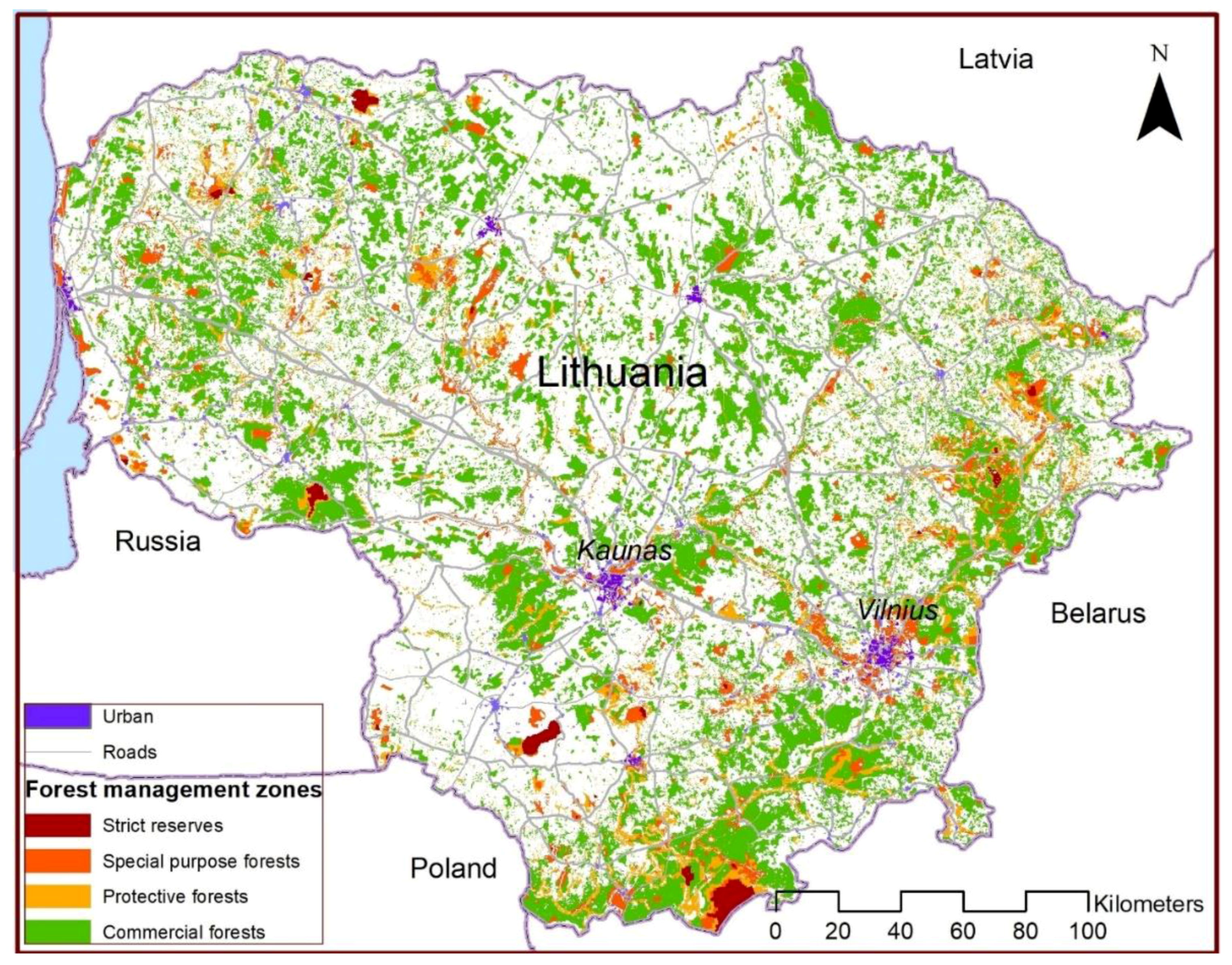
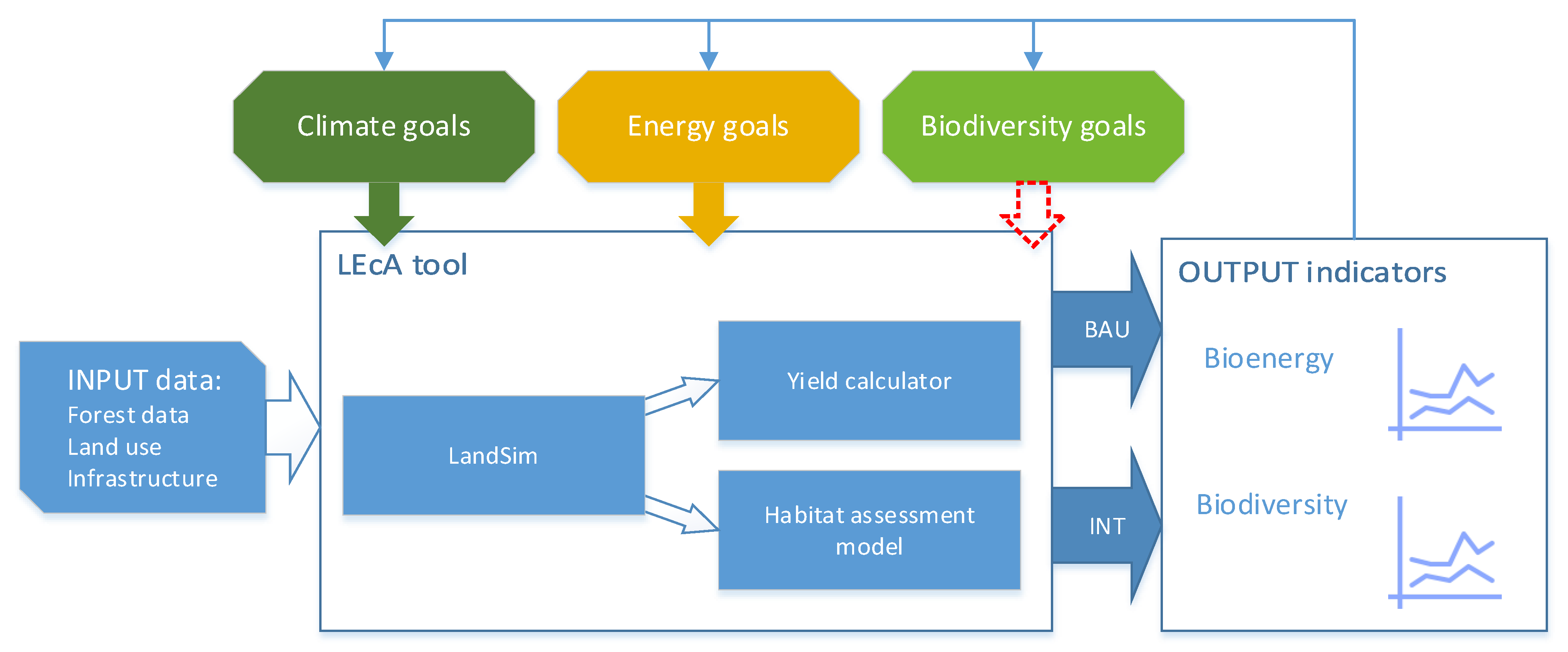

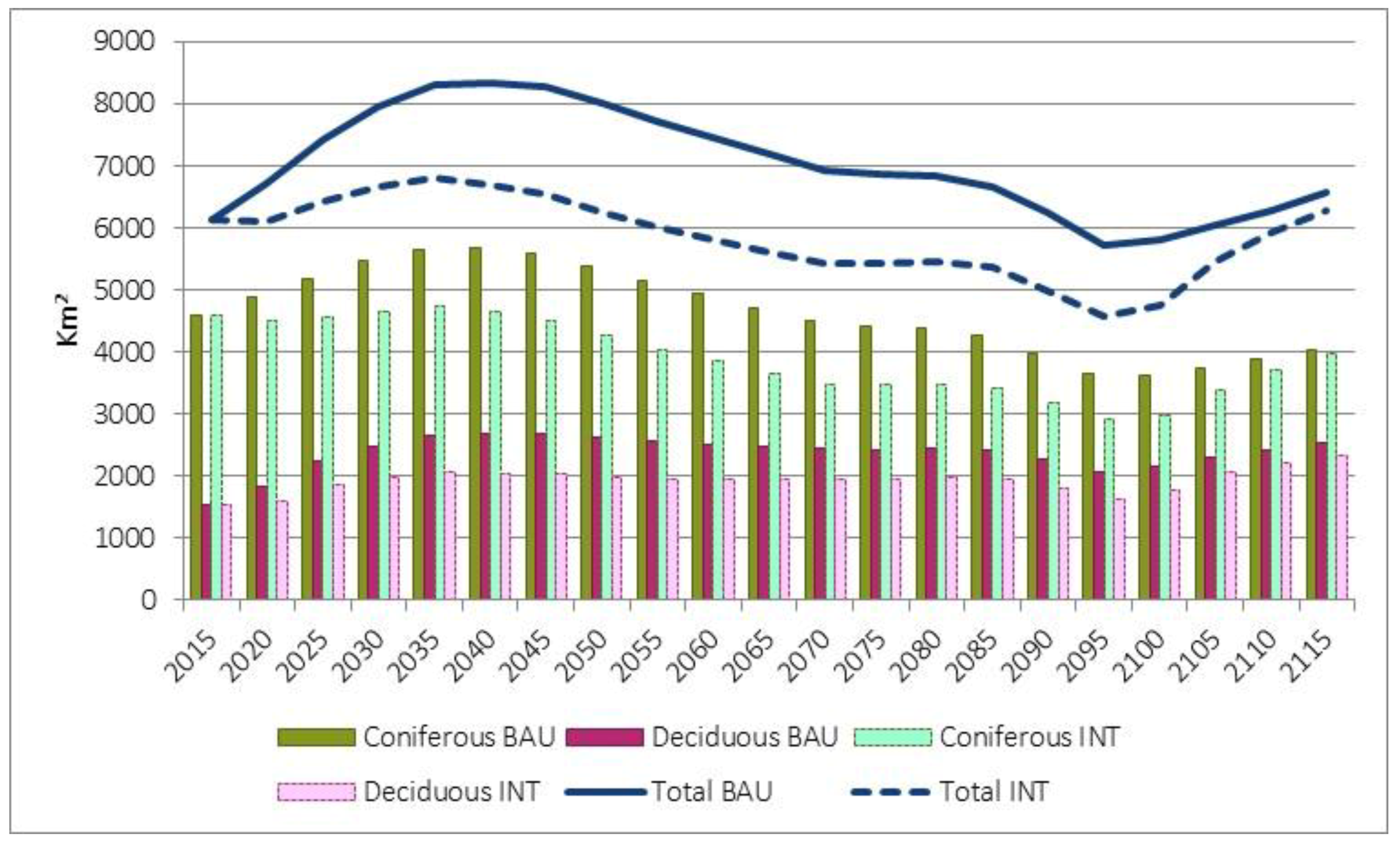
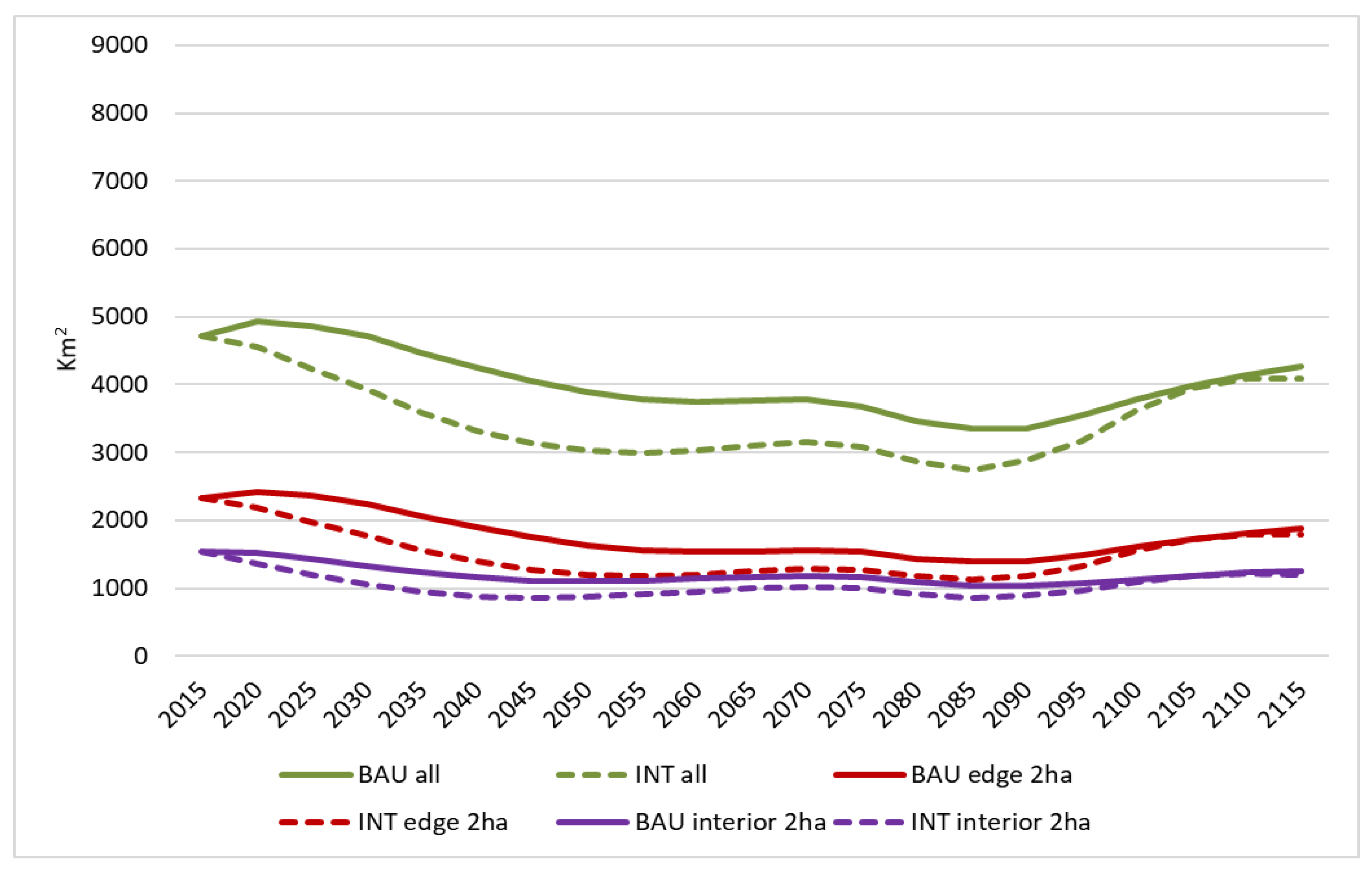

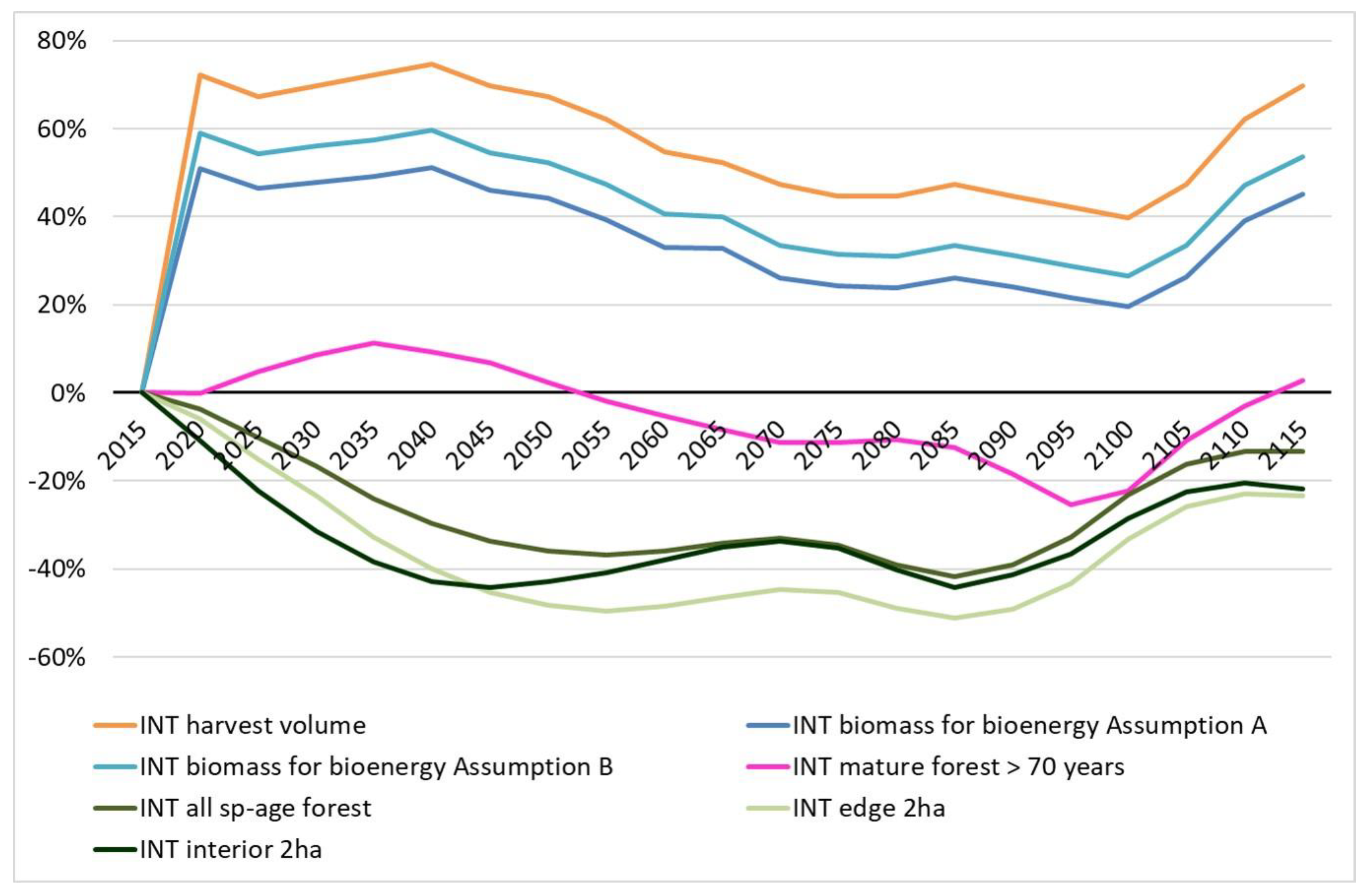
| Input Parameters | Use | |
|---|---|---|
| Description | ||
| Forest age | Mean age of forest stand in five-year classes (dynamic parameter, 33 classes) 1 | Forest simulation, bioenergy assessment, habitat assessment |
| Forest volume | Standing volume (stems) in forest with bark (dynamic parameter, 13 classes) 1 | Forest simulation, bioenergy assessment |
| Tree species | Dominating tree species (>50% of standing volume) (8 classes) 1 | Forest simulation, bioenergy assessment, habitat assessment |
| Productivity | Site productivity (2 classes) 1 | Forest simulation |
| Ownership | Ownership (2 classes) 1 | Forest simulation |
| Forest group | Forest management group related to current policy (4 classes) 1 | Forest simulation, bioenergy assessment |
| Agricultural land | Arable land and grasslands 2 | Habitat assessment |
| Output parameters (five-year time steps for 100 years) of the yield calculator | ||
| Firewood | Volume (roundwood) with bark | |
| Industrial wood | Volume (roundwood) with bark | |
| Industrial waste wood | Volume (chips and sawdust) | |
| Harvest residues | Volume (chips) | |
| Output parameters (five-year time steps for 100 years) of the habitat assessment model | ||
| Forest > 70 years | Area (km2) of all forest, coniferous forest and deciduous forest | |
| Older forest | Area (km2) of forest with species-specific age criteria | |
| Interior forest habitat | Area (km2) of interior forest habitat with species-specific age criteria and patch size criterion | |
| Edge forest habitat | Area (km2) of edge forest habitat with species-specific age criteria and patch size criterion | |
Publisher’s Note: MDPI stays neutral with regard to jurisdictional claims in published maps and institutional affiliations. |
© 2021 by the authors. Licensee MDPI, Basel, Switzerland. This article is an open access article distributed under the terms and conditions of the Creative Commons Attribution (CC BY) license (http://creativecommons.org/licenses/by/4.0/).
Share and Cite
Mörtberg, U.; Pang, X.-L.; Treinys, R.; Trubins, R.; Mozgeris, G. Sustainability Assessment of Intensified Forestry—Forest Bioenergy versus Forest Biodiversity Targeting Forest Birds. Sustainability 2021, 13, 2789. https://doi.org/10.3390/su13052789
Mörtberg U, Pang X-L, Treinys R, Trubins R, Mozgeris G. Sustainability Assessment of Intensified Forestry—Forest Bioenergy versus Forest Biodiversity Targeting Forest Birds. Sustainability. 2021; 13(5):2789. https://doi.org/10.3390/su13052789
Chicago/Turabian StyleMörtberg, Ulla, Xi-Lillian Pang, Rimgaudas Treinys, Renats Trubins, and Gintautas Mozgeris. 2021. "Sustainability Assessment of Intensified Forestry—Forest Bioenergy versus Forest Biodiversity Targeting Forest Birds" Sustainability 13, no. 5: 2789. https://doi.org/10.3390/su13052789








